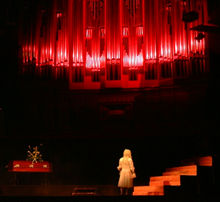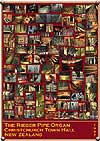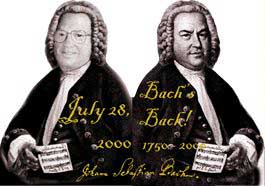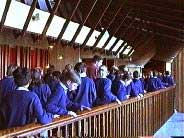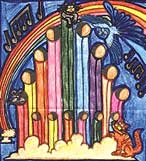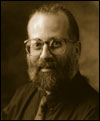 I’ll apologize upfront. This is a blatant non-commercial commercial…for me, for my program (Pipedreams), for my medium (public radio). Or is it more than that? Might you be involved in this picture, too? Let’s give it a look.
I’ll apologize upfront. This is a blatant non-commercial commercial…for me, for my program (Pipedreams), for my medium (public radio). Or is it more than that? Might you be involved in this picture, too? Let’s give it a look.
Much has been made of the minimal impact which organists and organ music have in today’s cultural scene. We organ lovers wail within our collegial fold, deplore the inequities of life, and then go back to working on the left-hand part of a new hymn harmonization for Sunday. Oddly, the situation does not correct itself.
Despite those many, many ranks of sonorous pipes upon which we play, we are a largely silent minority. An insignificant minority was how one audience analyst, working the already marginalized field of Public Radio, put it not long ago. People who enjoy organ music, though we like to imagine ourselves more numerous than the unemployed and more audible than the combined arsenals of the Wanamaker Store, Crystal Cathedral, West Point Chapel and Meyerson Symphony Center combined, in truth are not nearly as large or as noticeable a group as we might imagine.
And while it’s true that millions of people each week are exposed to organs and organ music, mostly in church settings, those same millions have not been seen regularly flocking to organ concerts and recitals. While we are fascinated by repertoire that extends from Buxheim to Bolcom, enraptured by Bach and Beauvarlet-Charpentier, Mendelssohn and Messiaen, not to mention the artistry of the Wright ‘Brothers’ (George and Searle), the general populace remains blissfully uninvolved in this tradition which our little group finds so rewarding.
Yes, little group, because we…members of the American Guild of Organists…are only a small number, not many more than 20,000 members of this proud, century-old assembly. Why are we so few? Partly because we (the AGO) are viewed, even by other colleague organists, as a class apart, an exclusive sub-set within an already miniscule sub-set. Partly, too, because as organists we tend toward specialization and polarization, fixating on a few small aspects of what is most certainly a very broad-reaching topic. Yes, the differences between Titelouze and Titcomb are important; they are wonderful. But are they mutually exclusive? To the general public it’s all just organ music. Our internecine squabbling succeeds only in blurring our public image (such as it may be).
The organ…such a convenient, simple term, and such a double-edged blade. How marvelous that we can cross-reference copulas and crash-cymbals all under one easy heading. Unfortunately, with similar ease, anyone discomfited by any marginal aspect of this broad topic can, with one flip of a subconscious switch, get “turned off” to organ music, or at best, become very confused.
Page through a concise history of the organ and you discover that, in each era and in every country, what constitutes “organ” and “organ music” resists an easy uniformity. Through personal experience, you’re well aware of the energy with which Belligerent Bachophiles eschew Fractious Franckists, Wild Wurlitzerites rebuff Supercilious Schnitgerians. Old music versus new, counterpoint versus color, mechanical versus electric, pipes versus electronic…are we organists a “family” (if such a diverse collective exhibits any relational energy) only insofar as the instrument we love is named organ? And, if so, even if our family suffers from multiple-personality-disorder…in spades…what’s wrong with our beginning to think of all of it as worthy of our enthusiasm?
Might not this become an advantage? What other instrument can embrace simultaneously two famous composers for the Phantom of the Opera theme (Bach and Webber)? This covers a lot of ground, but how much of it is common?
What do we do to reinforce a public awareness of the pipe organ? Not a lot, it seems. We lock the console and keep untrained curiosity-seekers at bay. We’d never spend the time to invite school music classes (or even Sunday School classes) in for an introductory demonstration. Then, when we schedule a recital, we’re late with our press releases, we don’t establish relationships with local newspaper arts editors or writers, we don’t coordinate our activities with other presenters (to avoid unnecessary simultaneities). Is it a wonder than our audiences are small?
Are we too proud to publicize? Much as we may wish it were otherwise, publicity and advertising are part of the energy of modern life. In ways more numerous and subtle than we might prefer, product marketing and attitude adjustments have impact on the way we view ourselves and the world in which we live and work. The Coca-Cola Company (which I pick at random from a huge list of potential exemplars), purveyors of a product known around the world, does not sit on its laurels, history, or traditions. Despite the fact that virtually every man, woman and child on this planet knows what Coca-Cola is, the Company spends billions of dollars annually reminding us of its product’s primacy in slaking our thirst and improving our life. Billion$ of dollar$ to refre$h our memorie$ about $omething we already know.
I know. The pipe organ community does not have billions of dollars to spend on publicity. But the pipe organ does have a few media ambassadors working on its behalf…The Joy of Music, with Diane Bish (television) and PIPEDREAMS (radio). Though some additional, locally-produced organ programs exist, these two mentioned are the only ones of which I am aware in national distribution. They are a precious pair, (since the broadcast industry’s attitude concerning organ music is one of disdain and loathing, only some of which is justified), but these programs do exist, they do reach out to audiences and have potential for being seen and heard by many more…if….
Our challenges may be distilled into two points:
- Connect with audiences who WANT to listen but don’t know the programs are there (or who cannot hear the programs because of non-carriage)
- Use audience/market information to mold a broadcast-industry-positive profile of the organ-music listener
An action plan is essential, and must begin immediately. Even with the best efforts, it will take nearly a year of involvement before any change will register. But don’t hold back just because the payoff isn’t instantaneous.
First, let’s energize the core…and that means you! More than 20,000 individuals are members of 352 local chapters of the American Guild of Organists, with representation in most of the major and minor cities of the nation. Though we are not the most manageable lot, as A.G.O. members we do offer a potential mechanism for efficient and economical outreach. (The 6000 members of the American Theatre Organ Society offer expanded potential, but perhaps that’s another story).
For the sake of this discussion, we will grant that all 20,000 A.G.O. members are church organists, and that as such each plays, on average, to “communities” (parishes, congregations) of 500 souls each week. Obviously, some play for huge congregations numbering in the thousands, others play for a hearty handful, but I think this nationwide ‘500-per-organist’ average is realistic.
Now, what IF we A.G.O. members were to involve ourselves in a bit of consistent self-promotion? How about putting the following regularly recurring listing (or something similar) into our church bulletins and/or church newsletters (perhaps alternating from one to the other each month, or more often….), or at the bottom of every organ recital program presented or sponsored by a guild member:
“If you’ve enjoyed the organ music today, you might also enjoy listening to PIPEDREAMS, a weekly 90-minute broadcast which features a broad cross-section of repertoire for the King of Instruments. Tune to WCLV-95.5FM Sundays beginning at 10PM. For more information, call 216-464-0900.”
[This, in fairness, could be expanded to mention other church-music-related media programming which might be available to your area, i.e. With Heart and Voice and even The Joy of Music on television, though for this article I’m focusing only on radio’s potential, perhaps shortsightedly…but that’s where I work.]
Think of the consequences of such a promotion, which happens at little or no cost. If done even only once, it reaches 10,000,000 (that’s ten million!) people…a significant number insofar as it represents more than half the total cume audience for all Public Radio listening. And, with recurrent placement, even if this outreach actually mobilized only a tenth of that number (not impossible, insofar as this constituency already is potentially organ-friendly, as compared with the general community at large), what a boost that might be…for organists, organ awareness and, not incidentally, for the local broadcaster (who, at least in Public Radio, is in pretty much the same predicament organists are…urgently in need of a mobilized constituency).
This, of course, presupposes that our Guild Chapters are regularly promoting these broadcasts to their individual members through monthly chapter newsletters. Unfortunately, the reality is otherwise. Even in communities where an A.G.O. chapter has donated hundreds (or thousands) of dollars from the chapter treasury to “underwrite” the broadcast of PIPEDREAMS on a local station, that same chapter may give absolutely no mention of PIPEDREAMS broadcast information in its monthly member mailings, presuming that everyone knows about it. Presumptions can be erroneous, even fatal.
We’ve got to get up and out there, folks. Remember the billions that commercial enterprises spend to reinforce their messages? We don’t have the billions (well, maybe we do…any closet philanthropists out there, waiting to fund a National Media Initiative for Increased Organ Awareness?), but we do have ourselves and some accessible and cost-efficient means of communicating with each other and with our communities of influence. All it takes is a bit of resolve, consistency, and follow-through.
Additionally, there is potential for interaction between station membership/ development folk and local A.G.O. members…to generate both individual membership support and (in the case of the larger chapters) perhaps also station underwriting monies (at least to cover out-of-pocket expenses to the station). A.G.O. chapter newsletters should also promote awareness of local Public Radio stations and, in particular, prep people for upcoming station fund drives. Hit the core audience, folks. Get them involved.
And also from the A.G.O. Chapter end, we should encouraged station management to foster and maintain these relationships, which can only help the overall Public Radio cause.
Yes, this is a challenging environment, for church music, for organ music, for Public Radio. But there are real opportunities here. It’s up to us to use them. You are only powerless if you refuse to use the powers in your possession. Don’t expect someone else to do it. Good luck!
© Michael Barone
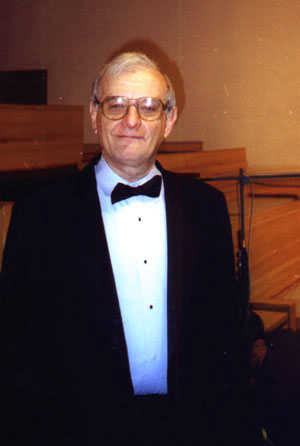
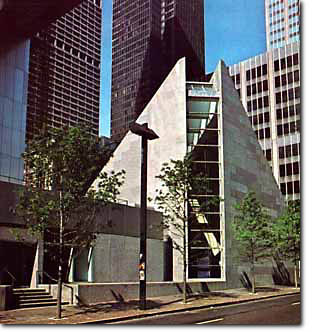 The minimalist modern architecture of St Peter’s was a perfect background for the highly spiritual music of Bach. Having never visited St Peter before, I was struck with it’s architect’s flight of imagination. I certainly have never seen a church where the sanctuary was below ground level, with ceiling windows facing the street. Several people were glued to the glass during the performance, and that created a feeling that the organ was speaking not only to us, sitting below, but also to the people outside, and to the sky, and to the entire city.
The minimalist modern architecture of St Peter’s was a perfect background for the highly spiritual music of Bach. Having never visited St Peter before, I was struck with it’s architect’s flight of imagination. I certainly have never seen a church where the sanctuary was below ground level, with ceiling windows facing the street. Several people were glued to the glass during the performance, and that created a feeling that the organ was speaking not only to us, sitting below, but also to the people outside, and to the sky, and to the entire city. BINGEN – It’s almost unbelievable: In spite of little advertising, even “unspectacular” organ concerts find their audience. Indeed, the listeners in the well-attended Catholic Church in Büdesheim were more than rewarded.
BINGEN – It’s almost unbelievable: In spite of little advertising, even “unspectacular” organ concerts find their audience. Indeed, the listeners in the well-attended Catholic Church in Büdesheim were more than rewarded. I’ll apologize upfront. This is a blatant non-commercial commercial…for me, for my program (Pipedreams), for my medium (public radio). Or is it more than that? Might you be involved in this picture, too? Let’s give it a look.
I’ll apologize upfront. This is a blatant non-commercial commercial…for me, for my program (Pipedreams), for my medium (public radio). Or is it more than that? Might you be involved in this picture, too? Let’s give it a look.
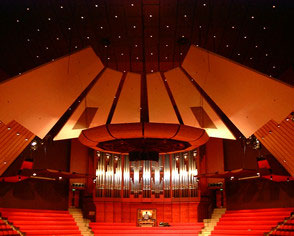 Over the last four years since its installation, the sustained, successful profile of the organ here has become something of phenomenon both locally, nationally and increasingly internationally. People often ask me to explain why and how this has happened. The honest truth is I’m not sure, but I guess it reflects a whole number of factors, not least civic pride (the people virtually gave the city its organ) and feast succeeding famine. But four years is too long a time to write off as a mere honeymoon period! (A preview of the first year can be read at
Over the last four years since its installation, the sustained, successful profile of the organ here has become something of phenomenon both locally, nationally and increasingly internationally. People often ask me to explain why and how this has happened. The honest truth is I’m not sure, but I guess it reflects a whole number of factors, not least civic pride (the people virtually gave the city its organ) and feast succeeding famine. But four years is too long a time to write off as a mere honeymoon period! (A preview of the first year can be read at 
